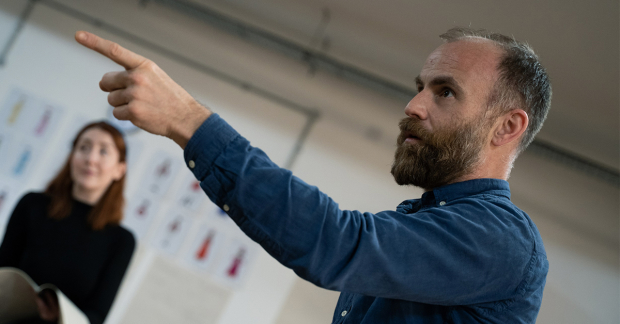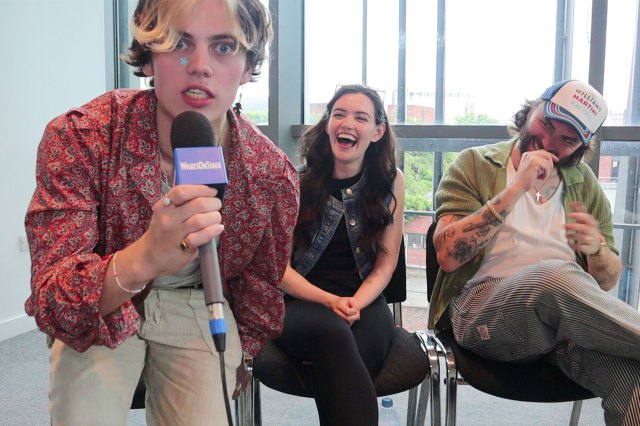Laurie Sansom: So you want to be an artistic director?
Ahead of the ”Quality Street” national tour, the CEO of Northern Broadsides theatre company shares his tips and tricks for starting a career in the arts

© Sam Taylor
Laurie Sansom begins his tenure as artistic director of Northern Broadsides with a revival of the J M Barrie play Quality Street, which opens today in Halifax before going on a tour around the UK.
The touring theatre company has championed Northern voices since 1992. Sansom joined in 2019 and has previously held artistic directorship roles at the National Theatre of Scotland – where he brought Rona Munro's The James Plays to the National Theatre in 2014 – and the Royal and Derngate, Northampton.
We asked Sansom to give us some tips and advice for cutting your teeth in the theatre world.
1) Can you introduce yourself?
I've been the artistic director and CEO of Northern Broadsides since last year, and before that lead the National Theatre of Scotland from 2013 to 2016. I was the artistic director of the Royal and Derngate, Northampton from 2006 to 2012.
2) When did you know that you wanted to be an artistic director?
I put together my own theatre company as a student called Flesh and Blood Theatre Group and we made new adaptations of Blood Wedding, The Bacchae and a devised musical about shopping so I guess even then I was playing at being an artistic director. Our shows were selected for the National Student Drama Festival, and it was there that I learnt quite how much I didn't know. It was the support and inspiration I received from its director – one of the unsung heroes of British theatre, the late Clive Wolfe – and visiting professionals such as Nicholas Phillips – who was at that time running the acting course at Central and taught me in an hour and half what I didn't know about acting – that gave me some confidence I might find a place in the industry.
3) What was the first project you worked on?
Follies – in 2006 I became artistic director at Royal and Derngate, Northampton shortly before it was to reopen after a major restoration. We decided to open with Sondheim's musical set on the eve of a theatre being pulled down. As well as having a fantastic cast of professional actors, the company also included local people from all over Northamptonshire. We had this wonderful cast of older women playing the ex-chorus girls, some in their 70s and 80s, delivering some of the show's most iconic numbers and bringing the house down every night.
It was the beginning of a community actors' group that is still going strong some 14 years later at Royal and Derngate, and was perhaps the prototype for my commitment to making professional work developed in collaboration with local people. It will always be one of the most rewarding experiences of my work as an artistic director. Watching them put themselves through the rigours of tap school everyday to master the Mirror number – headed up by fearless octogenarian Maureen Barwick who'd never been on a professional stage before – was profoundly moving.
4) Who helped you during the early part of your career?
You rely on so many people to throw you a lifeline when you start out. I was really struggling to get any experience within the professional theatre world and was working as a school storyteller to pay my rent. But then someone took a punt on me – Giles Croft invited me to be his assistant director at the Palace Theatre Watford as part of an Arts Council scheme, and it was here that I truly learnt the process of how to make theatre and run a building. Giles also gave me my first professional shows, one of which was J B Priestley's Dangerous Corner which Nica Burns then produced in the West End. Without people such as Giles and Nica, who were willing to take a risk on me as a young and sometimes naïve artist, you can feel like you'll never find a footing in what can seem like a very closed club with entry rules you don't understand.
Alan Ayckbourn then became a friend and mentor when he asked me to be his associate director at the Stephen Joseph Theatre in Scarborough. I learnt so much from his humility, generosity and light touch as an artistic director. In some ways we work very differently, but what we share is a love and respect for actors and writers. He is able to unlock a moment with the simplest of notes, miraculously transforming a scene. But it was his faith in my increasingly ambitious ideas that really allowed me to discover what kind of artist I wanted to be. He gave me free rein to create a version of Charlotte Brontë's Villette with Frantic Assembly and a season of new musicals performed by one company, always encouraging me to follow a creative idea through to its final conclusion.
Later on it was Donna Munday, CEO of Royal and Derngate who appointed me to my first artistic directorship, then Nicholas Hytner who greatly supported me by inviting me to bring work from Northampton to the National Theatre.
5) What advice would you give to anyone wanting to be an artistic director?
Get as much experience as you can about how boards work, how to deal with dysfunctional ones, and how to build effective relationships with your Chair. When these relationships go wrong they go horribly wrong. I am blessed with a very engaged Board at Broadsides, who share my excitement for the reboot of the company, while also having the skillset to challenge the executive team in a supportive way.
7) What resources proved most valuable to you during your early career?
The National Youth Theatre and National Student Drama Festival were both my training grounds. There wasn't the same culture of talent development in the industry then, and you really could only learn on the job. Artistic directors were the sole gatekeepers, and it wasn't until I secured one of the bursaries available to young directors that my career in the theatre really begun. I couldn't afford to work for free on the fringe or set up my own company, so I relied on building relationships with regional houses and drama schools. The New Vic under Gwenda Hughes, Salisbury Playhouse under Joanna Reid and Birmingham Rep under Tony Clarke all employed me as a young director, enabling me to make a living as I made work. But perhaps the most valuable resource are the experienced actors and creatives who teach you how to be better at your job.
8) What mistakes do you think are the easiest to make when starting out?
No one teaches you how to best work with senior managers when you first take over a company. Many people feel threatened by change, or have a vested interest in things not changing. A thoughtless word can escalate this nervousness, and I often wished I had the same innate interpersonal skills with managers as I seem to have with actors and creative teams. Because I'd done some (very rudimentary) acting myself, I've always felt comfortable collaborating with actor – I'm much less comfortable within the corporate structures of larger companies and how to judge my position within them. A word out of place to a marketing team can be just as damaging as a word out of place in the rehearsal room, and I've sometimes struggled with that.
9) What would you say is the most rewarding aspect of your job?
For me it's more the sharing of life experience in the rehearsal room than it is in the theatre. It's a space where we safely explore how we all view the world, how it's knocked us all about, and what our hopes are for the future. Somehow it means sharing a piece of theatre is always an optimistic gesture – it suggests it's possible to understand each other and the world better and therefore change ourselves and it.
10) What would you like to see in future generations of artistic directors?
That they entirely break the mould of previous generations and find new collaborative models of programming and making work. Slowly the picture of leadership in this country is changing, and I trust this will change arts organisations in ways it's impossible for me to even imagine.
Quality Street is on tour now, opening at the Viaduct Theatre, Halifax – book your tickets here




















